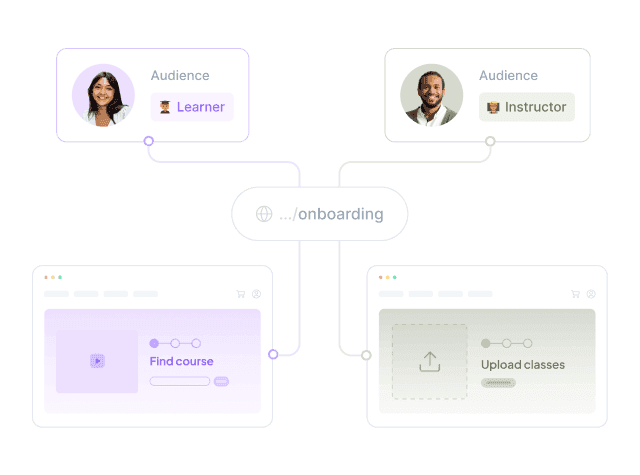You know personalization is crucial for driving growth, improving customer engagement, and increasing revenue. And that the longer you wait, the higher the opportunity cost. But how do you convince your boss to make the investment now?
As a growth marketer, you're aware of the impact personalization can have on achieving business goals faster and more efficiently. However, you may be facing two key challenges:
- Convincing your boss to invest
- Ensuring the strategy succeeds
We have good news for you: we've crafted a comprehensive action plan to help you make a compelling case for why personalization is a priority right now, not later.
The plan
Here's the thing: your boss cares about one thing above all—numbers. They want to know how every initiative contributes to the company's bottom line. So, while creating a more personalized experience for your users sounds great, you need to frame it as a business imperative, not just a "cool" feature.
Their ultimate goal is to increase revenue and drive efficiency. You need to demonstrate how personalization is a smarter revenue growth strategy than your current tactics. You'll do this by showing the impact on revenue and the opportunity cost of not acting now.
But how do you translate personalization gains into numbers your boss will care about?
First, start by answering these key questions to build your case:
- What's our current average conversion rate across key segments?
- What's our current monthly marketing investment, and what does that translate into in terms of annual recurring revenue (ARR)?
- If we were to double our marketing spend, what would happen to ARR over time?
- How would personalization affect our customer lifetime value (LTV) to customer acquisition cost (CAC) ratio?
Download our free template and find out how conversion rate optimization help you achieve your results faster.
A hypothetical example
Let's break it down with a hypothetical example. Imagine you're running marketing for a company, and these are your website's current metrics:
- 10,000 monthly organic visits
- 3% sign-up conversion rate
- 1% lead conversion rate
- Monthly campaign investment of $25,000
- Current ARR of $440k in 2024
Here's what your numbers would look like:
Now, let's explore two scenarios.
Doubling your marketing investment
Let's say you increase your marketing budget from 50,000 per month.
While this may bring in more traffic, without an optimized conversion strategy, the uplift may be minimal, and your acquisition costs could rise unsustainably. This is a costly growth method.
Investing in conversion optimization instead
Now, let's say you invest in a personalization strategy instead of increasing your budget.
The goal is to boost your conversion rates by just 10% through targeted content, personalized product recommendations, and tailored user journeys. Here's how your numbers could shift:
The ROI of personalization
With a 10% uplift in conversion rates, here's what you can expect:
Increase in ARR
A higher conversion rate directly boosts your ARR, leading to sustained growth over time without requiring a massive increase in marketing spend. In this example, a 10% boost could mean more than double ARR in 5 years, with your current investment levels, while doubling your marketing spend would only get you 25% more ARR in the same period.
Growth in customer base
More conversions result in a larger customer base, which drives long-term success. Personalized experiences make customers feel understood, improving loyalty and retention. Studies show that businesses using personalization strategies see a 20% increase in customer satisfaction and repeat purchase rates.
Reduction in CAC
A more efficient conversion process means you're spending less to acquire each customer. Personalization helps you focus on quality over quantity, making your marketing spend far more effective. By engaging users more personally, you create a seamless experience that drives purchases.
Stronger LTV/CAC ratio
Personalization accelerates your path to achieving a stronger LTV/CAC ratio. In our example, with personalization you could reach your target LTV/CAC of 5x by 2025 instead of 2027, significantly speeding up profitability and creating a healthier customer base.
Read our personalization guide and learn everything you should know about website personalization and how to get the best results.

The cost of inaction
Failing to implement personalization now will cost your company missed opportunities. The longer you wait, the more revenue you leave on the table.
Consumers expect businesses to meet their needs in real-time. By not investing in personalization, your company risks falling behind competitors who are already reaping the benefits of improved conversions, lower CAC, and increased customer loyalty.
Your turn: copy our template and make your case
Now that you have a clear roadmap, it's time to build your case.
We've made it easy for you by creating ready-to-use templates that lay out all the key numbers and business drivers you need to convince your boss. For SaaS businesses, they come in three versions:
- SaaS conversion growth model for businesses that rely on both product-led and sales motions, with sign-ups and demo requests as the main conversion rates.
- Product-led SaaS conversion growth model for product-led businesses with sign-up as the main conversion rate.
- Sales-led SaaS conversion growth model for sales-led businesses with demo requests as the main conversion rate.
If your business is not SaaS, but you still want to know what to expect from putting your efforts into optimizing conversion rates, check out our lead generation-focused template or even the one we did for e-commerce.
Personalization is the future—don't wait until 2025 to act. Let the results speak for themselves.
PS: and don't hesitate to ask for our help for this mission. We have a lot of experience with that :)